|
Save the Date:
Holiday Lunch
December 7
More details to come via email. |
| Upcoming Exhibitions | |
Jon Brooks: A Collaboration with Nature
NH Art Association
62nd Juried Exhibition |
|
2010-2011
Executive Committee
Officers
Executive Chair:
Thelma T. Raine
Executive Vice Chair:
Pat Howard
Treasurer:
Ted Parrot
Secretary:
Yvonne Dunham
Committee Chairs
Guild Ambassadors:
Frances Gray
Fran Wiggin
Guild Communications:
Judy McKenna
Pauline Bogaert
Guild Meetings & Programs:
Peg Case
Guild Membership:
Barbara Shepler
Museum Docents:
Carolyn Hollman
Museum Shop:
Richard Russell
Special Projects:
Pam Parrot
Zimmerman House Docents:
Dennie Dyer
|
The Currier Guild in action eNewsletter Staff:
Editors: Judy McKenna and Pauline Bogaert
Photo Editor: Anna Zhurbey
Production Assistance: Neva Cole, Michelle Pennington |
|
|
|
|
Guild of Volunteers Semi-Annual
Luncheon & Meeting Tuesday, November 16
Unveiling of Currier's Newest Purchase
Click here for details |
 Volunteer SpotlightAward Named in Memory of Fran Nelson Volunteer SpotlightAward Named in Memory of Fran Nelson
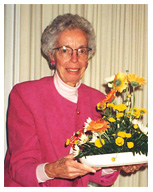 | | Frances P. Nelson |
The late Fran Nelson was a firecracker of a volunteer. In more than two decades, she chaired the Guild of Volunteers, Visitors Services, Zimmerman House docents, Membership/Development and Nominating committees, and was a member of the Currier's Board of Trustees and Advisory Council.
An indefatigable Guild of Volunteers and Currier supporter, she also took leads in the 60th Anniversary celebration, 1995 Capital Campaign, and 1997 Designer Show House, among other endeavors. For her decades-long service, she was awarded the Guild's 2006 Emerita Award that will now be named in her honor. The Frances P. Nelson Award will be determined by the executive committee. It is the Guild's highest honor and is given to an active or retired member in recognition of their years of service, leadership and volunteer hours.
"Fran was as dependable as they come," says Currier Director Susan Strickler. "Whenever I saw her sitting at the Visitor Services desk, I knew it was Thursday.
"She was also creative and forward-thinking," the director says. "She developed a wonderful 'flip book' of facts that the Z-House docents could refer to easily on a tour. She wrote the booklet and produced who-knows-how-many copies for her fellow docents. That's just the way Fran was."
Fran, a Louisville, KY native, came to Manchester in 1982 with her new husband Lloyd Nelson. At Fran's emerita award presentation, Currier Deputy Director Susan Leidy calculated in her 23 years at the Currier Fran had contributed 10,000 hours, the five-year equivalent of a staff member's time. "Fran Nelson's involvement will long be a part of the fabric of the Currier," the deputy director said upon Fran's death in 2007.
Sixteen-year Currier docent Marilyn Davison remembers Fran as tall and always well-dressed, and disliking computers. "She would have nothing to do with a computer. She typed up her reports, and there was never a mistake." Marilyn served four years on the board of the National Docent Symposium Council recording the minutes of the annual meetings. After the first meeting, she asked Fran to look over the report before sending it out to 24 symposium directors. "She was the perfect person to proof. I took the report over to her to check punctuation, word choice and grammar," she says. "With a sly grin, she would say, 'Dear, you don't do it that way or say it that way.' My reports were very good after that first time. She passed her knowledge along to me. She was an inspiration, no doubt about it."
Susan Leidy also recalls an annual meeting where Fran spoke about "saying yes" to volunteering. "Through reading and research, and strongly held beliefs," says the deputy director, "Fran understood what was required for leadership and she practiced it."
Spotlight by Pauline Bogaert |
From our Executive Chair
Volunteers are accustomed to change. Exhibitions change every couple of months; the number of docents change; museum educators change; visitors to the museum change; and even the number of tours volunteers are expected to give changes. The question is, is change good?
In Elizabeth Edward's book Resilience, she makes a point using these lyrics from Leonard Cohen's song "Anthem."
Ring the bells that still can ring, forget your perfect offering.
There is a crack in everything; that's how the light gets in.
That's an amazing insight to know nothing is perfect and is not intended to be. However, one thing that hasn't changed is that the Currier's Guild of Volunteers requires 50 hours to be considered an active volunteer. So stay open to change while Jane Seney partners with the Guild to write guidelines for better understanding of how changes can work for all volunteers.
 Thelma T. Raine, Executive Chair, Currier Guild of Volunteers Thelma T. Raine, Executive Chair, Currier Guild of Volunteers
|
 Zimmerman House Docents Attend FLW Conservancy Conference in Ohio Zimmerman House Docents Attend FLW Conservancy Conference in Ohio
In September, five current docents and one former Z-House docent attended the 2010 Annual Conference of The Frank Lloyd Wright Building Conservancy in Cincinnati, Ohio. Presenters spoke on the theme "Modifying Wright's Buildings and Their Sites: Additions, Subtractions, Adjacencies."
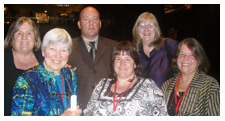 | | (L to R) Pat Morrison, Ann Milne, Peter Zalewski, Mary Morrison, Victoria Duffy, and Judith Ransmeier Photo by Mary Morrison |
The Currier group visited five Wright-designed buildings: Burton Wescott House,1906-08, in Springfield; Kenneth Meyers Medical Clinic, 1956, in Dayton; and a Usonian automatic, Gerald Tonkens House, 1954. They also toured the William Boswell House,1957-59, with Tom Olson, the apprentice who supervised construction for Taliesin and Boulter House, a 1954 two-story, rustic Usonian. They also toured local sites including Union Terminal, University of Cincinnati, a 1954 Richard Neutra-designed house and the 1955 Cincinnati Parks Administration Building, which has a strong Wright influence in its design.
Dennie Dyer, Zimmerman House Docent Chair
dennie.dyer@comcast.net
Z-House docents: If you have any comments or questions about your volunteer efforts, please feel free to contact Dennie Dyer to discuss.
Correction: Due to an editing error in the last issue, a sentence in the Zimmerman House report was incorrect. It should have been phrased: A reminder: class time (not travel or study time) is counted as docent hours.
|
 Museum Docents Prepare for New Exhibits with Walk-Throughs, Film and Field Trip Museum Docents Prepare for New Exhibits with Walk-Throughs, Film and Field Trip
The Secret Life of Art (SLA) opened October 2 and docents geared up for this new and exciting exhibit. In September, curators presented a detailed preview of the exhibit based on visitor questions, such as how the Currier acquires, lends, conserves, frames, and presents art. In October, Leah Fox, Jane Seney, Christa Zuber, and Michelle Pennington conducted a walk-through, always a high point in docent training. Jane provided exhibit handouts and tour tips preparing docents for visitors.
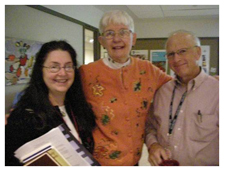 | | Kim Tyndall, Jean McGriffin and Jim Townsend at a recent docent meeting |
Docents will take a field trip and see a film during November. On November 2 we'll see The Rape of Europa, a documentary film that details the "systematic theft, deliberate destruction, and the miraculous survival" of priceless European art works during the Nazi terror of World War II. Two paintings in the SLA exhibit, St. Florian and St. Nepomuk by Martin Johann Schmidt (also called Kremser Schmidt), tell the story of how the two Nazi-looted pictures were finally returned to owner J. Thomas Selldorff after nearly 70 years.
The Andover, MA trip to the Addison Gallery of American Art on November 9 promises to be a delightful experience for museum docents. The Addison, part of Phillips Andover Academy, has recently completed a renovation and expansion that consists of a new Education Center and special exhibits. Staff-led tours of the permanent collection will include those of artists: Thomas Eakins, Winslow Homer, John Singer Sargent, James A. M. Whistler, and John Singleton Copley, and others. The gallery also has large holdings in photography and a significant contemporary collection.
I've recently read two articles of note examining the motives and expectations of those who visit museums. Judy Rand of Rand and Associates presented a paper called "The 227-Mile Museum, or Why We Need a Visitors' Bill of Rights" at the Visitor Studies Association, in which she cited a Visitors' Bill of Rights urging museums to put visitors' front and center when planning everything from fund-raising and publicity to preparing labels and designing exhibits.
In another article,"Common Beliefs about Visitors: Do We Really Understand Our Visitors?" author and retired professor Stephen Bitgood of Jacksonville State University reports on the behavior of people who visit a variety of institutions, including museums. Among his conclusions are most people read labels, at least a little, and overestimate the amount of time they spend at an exhibit or a museum. Visitors also "always turn right when they enter an exhibit hall," even though the "design of the room and the visual attractiveness of objects also influence the circulation flow." He also suggests the best way to tell if visitors have a high-interest level in a topic is to "assess their interest level by conducting a front-end evaluation."
We all agree that the Currier is "visitor-friendly" and we do our part to help. We docents put visitors first as we learn, share, and enjoy our knowledge with them.
Carolyn Hollman, Museum Docent Chair chollman@aol.com
Museum docents: if you have questions or comments related to your volunteer efforts, please feel free to contact Carolyn Hollman anytime to discuss. |
Secret No Longer
Museum Staff Shares Secrets of New Exhibition
About 60 museum and Z-House docents spent nearly two hours touring the Currier's newest exhibit, The Secret Life of Art, Oct. 5 with Public Programs staffers Jane Seney, Leah Fox, Christa Zuber and Michelle Pennington.
 | | Michelle Pennington, Christa Zuber and Leah Fox (shown l-r) along with Jane Seney, shared walk-through presentations of The Secret Life of Art exhibition. |
Reactions to the exhibit were positive and elicited such comments as "extraordinary" and "terrific." Jane Seney called the exhibit "the most labor intensive exhibit ever undertaken" by the museum. Christa Zuber, speaking in the section involving packaging art for shipment, compared crating art work with the "Egg Drop" experiment done in grade school. The test involved nestling fresh eggs in padding material, then dropping the bundle to see whether the eggs remained whole or became a squishy mess. With art crating we saw examples of all the materials used in crates to protect precious paintings. In the "In the Galleries" section, Jane called attention to visitors' responses to Adolph Gottlieb's From Midnight to Dawn. One creative haiku writer penned: Midnight to dawn ... day Sinking deeper and darker Then blue, black, hook, night Another wrote: "Suddenly realizing you're almost nose-to-nose with someone else in the dark (they have curly hair)."
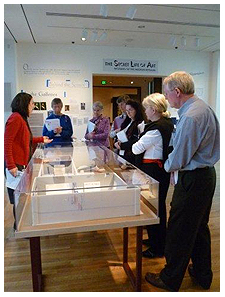 | Leah Fox describes the creation of
a scale model for the exhibition. |
In creating an exhibit space, Leah Fox told about choosing room colors. "We go to a local retailer just like anybody else," she said, adding they use Benjamin Moore paint. She said exhibit designers first pick up paint chips; then select a chip color that will enhance the art work.
In an examination of work between Josef Albers, and his student Robert Rauschenberg, it was pointed out how one painting can change dramatically when paired with others. Rauschenberg's 1968 lithograph Gamble is paired with three of his teacher Josef Albers, Multiplex A, B, and C in the exhibit. Gamble is a jumble of loosely constructed rounds, squares and items having to do with the human effort of taking a gamble. On the other hand, Albers three woodcuts of squares and rectangles appear structured in comparison.
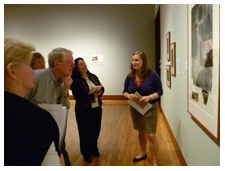 | | Jane Seney compares Alber's work with that of Rauschenberg as Jim Bennett and Kim Tyndall react. |
Rauschenberg quipped about Albers as his teacher: "He was my best teacher and I was his worst student." - By Pauline Bogaert |
 Tosa or Kanō? A Z-House Mystery Tosa or Kanō? A Z-House Mystery
The Secret Life of Art exhibition shows the architectural plan of the Zimmerman House evolving through several designs. The furnishing of the house was part of this evolutionary process. As Frank Lloyd Wright and apprentice John Geiger worked toward the realization of a complete work of art, a Japanese screen became the grace note in the symphony of the Garden Room. But what, really, is it?
 | | Z-House Japanese Screen |
Somewhere along the way (it is not known how, why, or when), the attribution of the screen was changed from Tosa School to Kanō School. This was brought to my attention when one of our visitors objected to the designation of Kanō. A Japanese man introduced himself as a Japanese art historian and museum curator, and was emphatic that the screen was "not Kanō."In researching the Zimmerman House files, the screen was identified as "Tosa School, 18th Century" in the following documents: · The bill of sale from H. Yatsuhashi, Inc., 420 Boylston Street, Boston, MA. · The 1988 Currier Annual Report listing the Zimmermans' bequest · Various reports pertaining to the conservation of the screen (ca. 1988) · The Currier Museum of Art website I could find no formal appraisal or assessment that officially changes the attribution. Yet, both the Docent Guidebook and Zimmerman House book, A Work of Art for Kindred Spirits, sold at the Museum Shop identify the screen as Kanō. We don't know the reason for this change, but it may have been an accidental transposition (two smaller tea screens are Kanō School). Or it may be correct, although there is no documentation in the registrar's file that verifies the change to Kanō. So, it seems the less said about the school of origin, the better. To focus on the intrinsic beauty of the screen and its importance in the design of the house would be beyond doubt - even to a Japanese scholar. Dennie Dyer, Zimmerman House Docent Chair with Victoria Duffy, Zimmerman House Docent |
|
 Is Art Interpretation Up to Us? Is Art Interpretation Up to Us?
Join the Conversation on Our New Guild of Volunteers Blog
As I write this, the entire staff is busily preparing for the opening of The Secret Life of Art. Our goal with the exhibition is to "lift the curtain" on those activities of the museum that people have asked most about, from how the museum collects art to what the staff considers when writing - or recording - information about the art. This information conveyed by the museum - which can appear in many formats, including labels, brochures, audio tours and even docent tours - generally falls under the rubric of museum "interpretation."
In keeping with the exhibition's theme and learning more about how decisions are made in museums, I offer this short essay about the word interpretation in museums, which has been used for well over fifty years, and whether for educational practices that word might be obsolete. In the 1994 Handbook for Museums by Gary Edson and David Dean, interpretation is described as "the process of making something understandable or of giving something a special meaning." Though all good interpretation is described as a "two-way street" between the museum and visitor, what does the word itself imply?
Although we have gotten used to the term interpretation, what message are we giving our audiences by using it? According to the dictionary, interpretation is "an explanation of the meaning of another's artistic or creative work." By using the term interpretation, are we giving the message to audiences that art requires an intermediary to translate it for the public? In fact, when we present interactive tours and ask visitors their reaction to art, aren't we telling them it is valid to interpret art themselves, based on their own life experiences?
Current media - including the Internet - invites audiences more and more to participate in unmediated discussions. This unquestionably leads to much uninformed and less-than-useful dialogue. It also empowers some people to be part of discussions in which they thought they had no role because of perceptions about their background, education or social status. Isn't this an empowerment museums should embrace, particularly as they seek to expand and diversify their audiences? Is one of the reasons some people are intimidated by museums because they feel their response to the works may not be right? Good examples of inviting visitors to express their thoughts are the exhibit's educational components for the Marisol and the Gottlieb.
Providing information about art in many formats and for visitors of every age and background is critical to the mission of the museum as an educational institution. Should, however, museums re-think the word interpretation, recognizing it as a relic from the past that needed art to be translated?
Join the conversation by logging on to our new Guild of Volunteers blog at: www.currierguild.blogspot.com. Click on "comments" at the bottom of the essay and let us know your thoughts.
Susan Leidy, Deputy Director
leidy@currier.org or (603) 669-6144, ext. 106 |
 Unveiling of Currier's New Purchase Planned for Semi-Annual Guild Meeting Unveiling of Currier's New Purchase Planned for Semi-Annual Guild Meeting
November 16 - Winter Garden
Guest speaker, Nina Gara Bozicnik, Assistant Curator at the Currier Museum of Art, will present "Direct from Auction: Introducing the Currier's Newest Contemporary Purchase" at the Guild of Volunteers semi-annual luncheon and meeting on Tuesday, November 16 in the Winter Garden Cafe. Registration and coffee starts at 10:45 followed by the meeting and lunch at 11:00.
Service awards will also be presented at the meeting (see below). We look forward to seeing all volunteers at this fun and informative event.
|
Guild Service Awards Presented at Meeting
We will be presenting service awards to guild members at our November 16 semi-annual luncheon and meeting. That means everyone needs to enter their volunteer hours to be counted correctly. It would be helpful if all volunteers would enter their hours in a timely manner, at least once a month. Also, please remember that all guild volunteers are responsible for annually renewing their museum memberships.
The new class of museum docents received a Guild orientation on October 13. Welcome to all!
Barbara Shepler, Membership Chair
Membership Assistant needed to help Barbara with record keeping and to learn the program for recording hours. Work entails several hours a month. If interested, call Barbara at 494-6015 or email: barbara.shepler@yahoo.com. |
 Museum Shop News Museum Shop News
One Week Only - Volunteers Offered 30 Percent Off
The Museum Shop has a large selection of 2011 calendars, wall calendars, and engagement books to start off the New Year right or for your holiday gift-giving. We also have a good supply for greeting cards now on display. Remember: Guild members always receive a 20 percent discount on their purchases.
A special selection of books related to The Secret Life of Art exhibition are now on sale. These include A Closer Look: Conservation of Paintings by David Bomford, Jill Dunkerton, and Martin Wyld; A Closer Look: Colour by David Bomford, Ashok Roy; The Winterthur Guide to Caring for Your Collection; and Secret Lives of Frames: One Hundred Years of Art and Artistry by Deborah Davis, Gerardo Samoza (Photographer).
During the week of November 28 to December 4, 2010, all docents, volunteers and staff will receive a 30 percent discount. Shop early, shop late, but shop the varied selection of merchandise at the Museum Shop.
Richard Russell, Museum Shop Chair
rrr1944@motleythebear.com
|
|
 The Book Shelf The Book Shelf
What Jane Seney is reading...
 I am currently reading The Monuments Men: Allied Heroes, Nazi Thieves and the Greatest Treasure Hunt in History by Robert Edsel. The non-fiction book outlines the role art played during World War II and sheds light on the international team of art experts who helped save art and architectural treasures from destruction or theft. Since the Secret Life of Art deals specifically with provenance research, this is a great book for broader understanding of how Nazis systematically looted or destroyed cultural artifacts during the war. I am currently reading The Monuments Men: Allied Heroes, Nazi Thieves and the Greatest Treasure Hunt in History by Robert Edsel. The non-fiction book outlines the role art played during World War II and sheds light on the international team of art experts who helped save art and architectural treasures from destruction or theft. Since the Secret Life of Art deals specifically with provenance research, this is a great book for broader understanding of how Nazis systematically looted or destroyed cultural artifacts during the war.
I also recommend Museum: Behind the Scenes at the Metropolitan Museum of Art by Danny Danziger. The book is a compilation of short essays on the daily lives of people that work at the museum ---- from maintenance workers and waitresses to curators and trustees (though there is a disappointing lack of docents and educators). It's a good peek behind the scenes.
Jane Seney, Educator for Tour and Docent Programs |
Welcome Our E-News Photo Editor
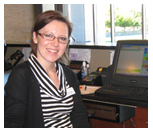 | | Anna Zhurbey |
The Guild newsletter has added a photo editor, Anna Zhurbey who will edit photos for In Action. She is originally from Zhitomir, Ukraine. She studied history at Jagiellonian University in Kraków, Poland, and currently lives in Manchester. Anna is a visitor services representative and museum shop volunteer. Her favorite work of art is Hide and Seek by Pavel Tchelitchew at the Museum of Modern Art in New York City. |
Milestones
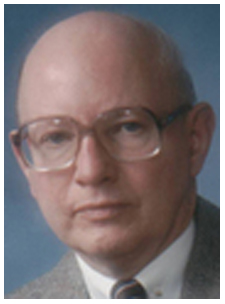 | | Richard McCarthy, MD |
Most of you have heard that our fellow museum and Zimmerman House docent, Richard McCarthy, passed away on September 9, 2010. As a new docent, Richard was one of the people I shadowed and tried to emulate. He was always very helpful, encouraging and supportive. In addition to being an active docent, he served as Executive Chair of the Guild. Words that others have used to describe him are: thoughtful, upbeat, smiling, humane, gentleman, dedicated, and kind. I think one person summed him up best: SPECIAL. He will be missed.
- By Dennie Dyer |
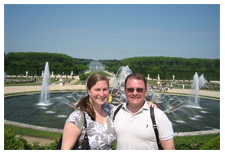 | |
Jane and Dean touring the Versailles gardens. |
Jane Seney and Dean Slye - On June 19, 2010, Currier Docent Educator Jane Seney wed Dean Slye in Jamestown, RI. They honeymooned in Edinburgh, Paris and Florence. Congratulations to Jane and Dean. |
| Museum docent Elaine McCartney celebrated her 50th birthday in August at a birthday dinner in a grand chateau in France. Happy Birthday! |
|
|
|
|
|
|